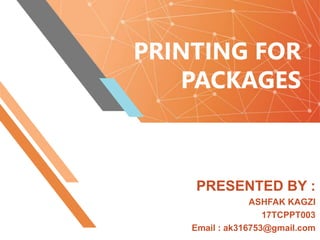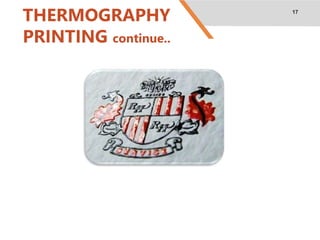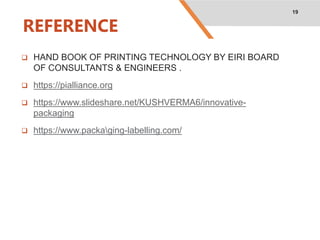Printing for packages
- 1. PRINTING FOR PACKAGES PRESENTED BY : ASHFAK KAGZI 17TCPPT003 Email : ak316753@gmail.com
- 2. INTRODUCTION 2 WHAT IS PRINTING ? Printing Is A Process For Reproducing Text And Image, Typically With Ink On Paper Using A Printing Press.
- 3. Why We Should Choose Printing for Packaging ? • Print helps to retain customers. • Print lets people “unplug.” • Print attracts more attention the digital media. 3
- 4. PRINTED PRODUCTS 4 The chart below is from a presentation by Frank Romano, professor at the Rochester Institute of Technology. It lists the various applications of industrial printing and dates from 2008.
- 5. PRINTING MARKET Printing companies can be categorized based on the type of customers they serve, the types of jobs they print and the equipment they use. The printing market is often split into 4 segments: • quick printers, forms printers, wide format printers, direct mail printers Commercial printing • boxes, cartons, bags, cans, tags and labels. Packaging printing • Newspaper printers, book printers, magazine printers or directory printers target Publication printing • An in-plant is a printing facilities that is part of a company or institution and only produces print for its own employer. In-plants 5
- 6. TYPES OF PRINTING Digital printing Electrostatic printing Flexography Embossing Gravure printing Letterpress Offset lithography Screen printing Thermography 6
- 7. DIGITAL PRINTING Digital Printing Is The Reproduction Of Digital Images On Physical Surface. Utilization Of This Technique In Different Process 7
- 8. EMBOSS PRINTING Embossing Is A Technique Which Creates A Raised, Or 3- dimensional, Image On A Piece Of Paper. There Are Two Ways To Emboss: Dry Embossing Heat Embossing Dry Embossing, Also Called Relief Embossing, Is Done Using A Stylus, Stencil, And A Few Other Supplies. Heat Embossing, Also Called Stamp And Heat Embossing, Is Done Using Special Powder, Ink, And A Heat Source. 8
- 9. FLEXOGRAPHY This is the process used to print packaging materials such as plastic bags, grocery bags, gift wrap or can and bottle labels. It is basically an updated version of letterpress. It much more versatile than letterpress in that it can be used for printing on almost any type of substrate including plastic, metallic films, cellophane, and paper. Flexography continues to be one of the fastest growing print processes and is no longer reserved just for printing specialty items. Food packaging is an important market because of the ability of flexography to print on non-porous substrates. This ability makes it useful for printing on plastic bags as well. 9
- 10. FLEXOGRAPHY continue.. Approximately utilization of this technique in different process Flexographic process 10
- 12. GRAVURE PRINTING • This is an expensive but high quality printing technique that uses direct contact between an etched copper plate and the paper. • While the plate has a relatively high cost, this technique is the best way to print high quality, large volume materials such as brochures, magazines, annual reports and mail order catalogues. • Gravure is used for many packaging applications, magazines, and pressure sensitive labels. Approximately utilization of this technique in different process 12
- 13. LETTERPRESS PRINTING • This is the original printing process that was introduced way back in the fifteenth century. • It uses images on the plate that are slightly raised from the surface (like a rubber stamp). Few printers offer fine letterpress anymore. • The letterpress process utilizes an ink that is thick in consistency and is well suited for relief printing. 13
- 14. OFFSET LITHOGRAPHY PRINTING • A popular printing method offered by almost every printer. • Used to print any variety of different textured materials, this process uses ink economically and requires little time to set up the press. • It is used for almost all printing on paper, including newspapers, magazines, brochures, etc. 14
- 15. SCREEN PRINTING Also known as silk screening, this process forces ink through a screen, like a stencil pattern. Often used for non-flat goods, this method is best equipped to print on items like mugs, clothing, ring binders, bumper stickers or billboards. Screen printing has been used for centuries and although there have been many improvements with the technology. 15
- 16. THERMOGRAPHY PRINTING • This is a print finishing process that produces a raised image. • This process dusts a previously printed image with a powder before the image's ink has been allowed to dry. • Applying heat makes the powder and the ink fuse and form a raised image. This process is mainly used for stationery. • Thermography is the process of spreading thermal powders on the wet ink of a print application and heating it in order to melt the powder into a single solid mass which is raised above the printed surface. • It is also known as “ imitation engraving ”. 16
- 18. THE ADVANTAGES OF PRINTED COMMUNICATION • Many types of print media (newspapers and magazines) still have a loyal readership. They remain a valuable part of the marketing mix of advertisers. • Print allows for easy distribution to a particular geographical region. • Many printed publications have a reputation that is as yet unrivaled by on-line or electronic media. • Print media are often more engaging than their electronic counterparts. 18
- 19. REFERENCE HAND BOOK OF PRINTING TECHNOLOGY BY EIRI BOARD OF CONSULTANTS & ENGINEERS . https://pialliance.org https://www.slideshare.net/KUSHVERMA6/innovative- packaging https://www.packaging-labelling.com/ 19
- 20. 20



















